Monday, 18 June 2012: Caen to Bayeux, via Pointe du Hoc
Written 3 July 2012
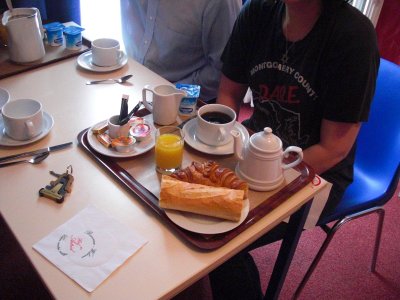 The Hôtel Astrid has no breakfast room. You therefore specify the night before what time you want your breakfast and what hot drink you want with it, and they bring it to your room on a tray. Our room was quite large and included a table and four chairs, so CJ just joined us at breakfast time. Here's her tray, with a croissant, bread, butter, jam, OJ, plain yogurt, and coffee. Ours was the same but with two of everything and with hot chocolate (because they didn't have decaf).
The Hôtel Astrid has no breakfast room. You therefore specify the night before what time you want your breakfast and what hot drink you want with it, and they bring it to your room on a tray. Our room was quite large and included a table and four chairs, so CJ just joined us at breakfast time. Here's her tray, with a croissant, bread, butter, jam, OJ, plain yogurt, and coffee. Ours was the same but with two of everything and with hot chocolate (because they didn't have decaf).
Breakfast over, we packed everything up and piled it in the lobby, checked out, and then brought the car around and double-parked it long enough to load our bags. Then it was off to the coast to resume our tour of the beaches. This time, we started a little west of Arromanches, where we'd left off the day before and drove to Omaha Beach, where the American cemetery is located. It was our third visit to the site, and I can't really improve on my description from my 15 May 2005 blog entry: "The cemetery is particularly moving—David and I remembered it vividly from our previous visit. The grounds are immaculate, and the lawns are mowed with military precision in a criss-cross pattern. At one end is a large semicircular monument on which are engraved two huge maps of the battlegrounds of Normandy. In the center is a tiny chapel containing the emblems of many religions and decorated with modern stained-glass windows depicting different branches of the armed forces. Around the chapel are arrayed, in perfect, slightly curved lines, many thousand pure white Carrera marble crosses, interspersed here and there with stars of David. Each is engraved with the name, rank, home state, and date of death of the soldier buried there; on the back, near the ground is his dog-tag number. Here and there, you come to one that reads 'Here rests in honored glory a companion in arms known but to God'; the back is blank. Lt. General Leslie McNair's grave occupies a corner position, but otherwise, we could see no pattern. Officers and enlisted men, Christians and Jews, those who died on the beach on D-Day and those killed weeks later during the campaign all mingle in the rows. "
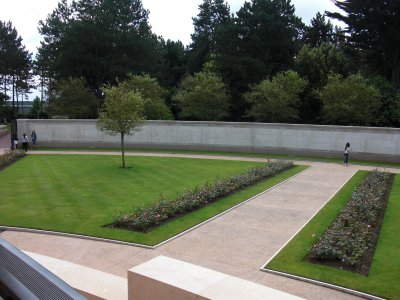
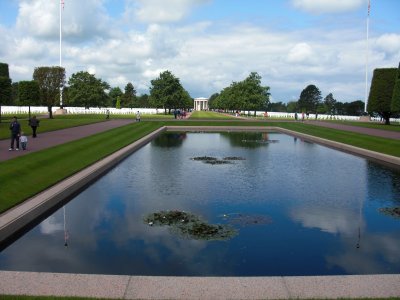 Behind the semicircular monument is this long, semicircular wall (at the left, about 1/4 of it visible in the photo) on which are engraved the thousands of names of those with no known graves. In front of it is this vista down the center axis toward the little chapel. Remember that the chapel marks only the half-way point—as many graves continue on beyond it.
Behind the semicircular monument is this long, semicircular wall (at the left, about 1/4 of it visible in the photo) on which are engraved the thousands of names of those with no known graves. In front of it is this vista down the center axis toward the little chapel. Remember that the chapel marks only the half-way point—as many graves continue on beyond it.
As you can see, although individual graves are sometimes decorated with cut flowers, the only plant actually growing on the graves is grass.
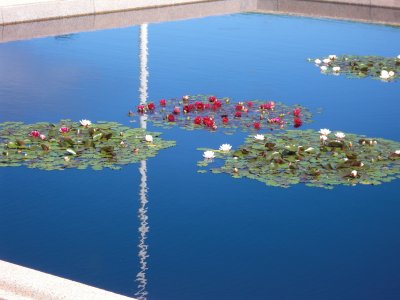
 On the left is a closer view of the beautiful water lilies blooming in the reflecting pool.
On the left is a closer view of the beautiful water lilies blooming in the reflecting pool.
At the right, David and CJ look back at the monument from among the first rows of graves. As you can see, quite a few other people, mostly American, were visiting on the same day.
On the way back to the car, we stopped at the visitors' center, which now includes a museum (new since our last visit).
The museum displayed biographical sketches and profiles of many individual men who fought on D-Day and later in Normandy as well as other artefacts. One item we'd already seen an example of was a "Rupert," a canvas dummy, about half the size of a person, loaded with an explosive charge. In the process of creating a diversion intended to fool the Germans into thinking that the invasion was taking place elsewhere, thousands of Ruperts were dropped from airplanes to parachute to the ground away from the real invasion zone. The explosive charge detonated on impact and served only to destroy the dummy, to delay discovery of the ruse.
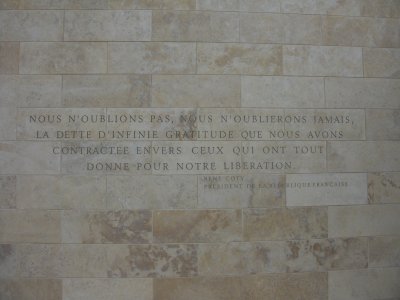
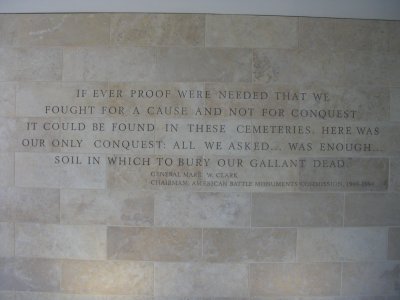 These two quotations were engraved on walls of the museum. The French one reads "We do not forget, we will never forget, the debt of infinite gratitude that we have incurred toward those who gave their all for our liberation" (René Coty, a former president of France). The English one says, "If ever proof were needed that we fought for a cause and not for conquest, it would be found in these cemeteries. Here was our only conquest. All we asked . . . was enough soil in which to bury our gallant dead" (General Mark W. Clark, Chairman, American Battle Monuments Commission, 1969–1984).
These two quotations were engraved on walls of the museum. The French one reads "We do not forget, we will never forget, the debt of infinite gratitude that we have incurred toward those who gave their all for our liberation" (René Coty, a former president of France). The English one says, "If ever proof were needed that we fought for a cause and not for conquest, it would be found in these cemeteries. Here was our only conquest. All we asked . . . was enough soil in which to bury our gallant dead" (General Mark W. Clark, Chairman, American Battle Monuments Commission, 1969–1984).
The walkway from one part of the museum to another passes through a long hallway where a woman's voice simple reads name after name of those who died here. I asked a guard how long the list goes on before beginning again—the answer was 36 hours.
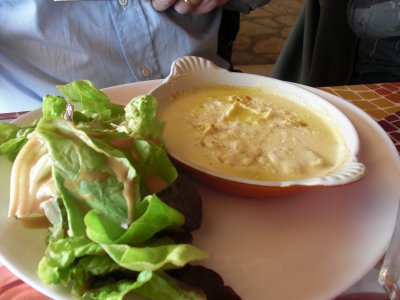
 For lunch, we stopped at the Hotel du Casino, overlooking the beach near Arromanches. David had a sort of fondu of camembert, lightly browned under the broiler, into which he dipped bagette chunks.
For lunch, we stopped at the Hotel du Casino, overlooking the beach near Arromanches. David had a sort of fondu of camembert, lightly browned under the broiler, into which he dipped bagette chunks.
CJ had another cheese omelette, which she pronounced entirely satisfactory.
I, however, jumped at the chance of a cold local crustacean with mayo.

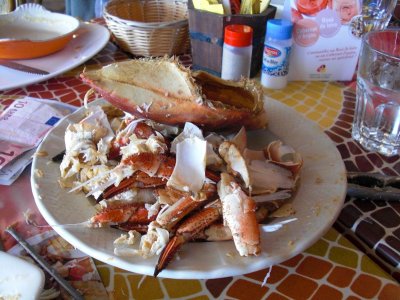 Here's my cold, cooked "tourteaux" crab (Cancer pagurus), before and after I dealt with it. The kitchen had lifted the carapace and removed the gills and cartilaginous stomach sac before setting it back in place, but it was otherwise intact. I was brought a serious shell cracker (visible behind the glass dish of mayo) and one of those skinny little two-tined seafood forks with which to tackle it.
Here's my cold, cooked "tourteaux" crab (Cancer pagurus), before and after I dealt with it. The kitchen had lifted the carapace and removed the gills and cartilaginous stomach sac before setting it back in place, but it was otherwise intact. I was brought a serious shell cracker (visible behind the glass dish of mayo) and one of those skinny little two-tined seafood forks with which to tackle it.
As usual, David and CJ had long since finished their meals and the rest of the bread, planned the rest of the day, and drummed their fingers for some time before I finished extracting all the goodies from the smallest legs, but it was wonderful. I promised not to order it again.

 Our next stop was la Pointe du Hoc, a high, prominent point of land that commanded a vast swath of the sea between Omaha and Utah beaches and, once heavily fortified by the Gemans, could shell both landing areas. We had been able to see it, marked by the distinctive freestanding rocky point, all the way from Gold Beach, a good 30 km away.
Our next stop was la Pointe du Hoc, a high, prominent point of land that commanded a vast swath of the sea between Omaha and Utah beaches and, once heavily fortified by the Gemans, could shell both landing areas. We had been able to see it, marked by the distinctive freestanding rocky point, all the way from Gold Beach, a good 30 km away.
On D-Day, to take out the big guns on top, American rangers scaled it from the beach (they carried specially designed devices that shot grappling hooks up over the top) under terrible fire, sustaining heavy losses, only to find that the "big guns" they could see from below were wooden. The Germans were short of fire power, so they had moved most of the real guns elsewhere and left decoys in their places. The five remaining guns had been moved inland, where the rangers found them and disabled them. One of them remains in place for viewing today.
At the right is a closer view of the monument in the form of a rough-hewn granite sword that you can see at the edge of the cliff in the left-hand photo. As you can see, we actually had a mostly sunny day.
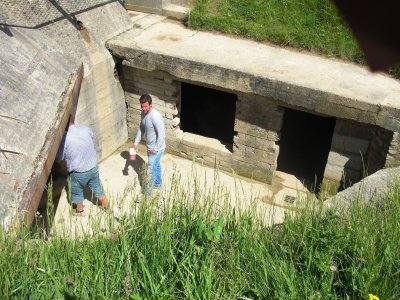
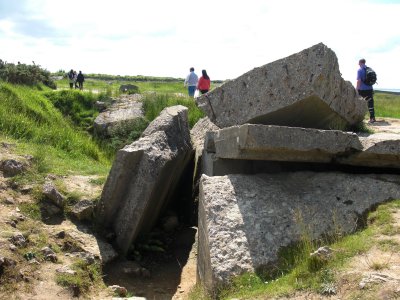 The fortifications were certainly impressive—a whole warren of concrete bunkers, blockhouses, and tunnels built into the point and the land beyind it. Some were quite intact, like the subterranean section at the left. You could walk around and explore many of them and peer down airshafts into others. The whole area was deeply pocked with shell holes.
The fortifications were certainly impressive—a whole warren of concrete bunkers, blockhouses, and tunnels built into the point and the land beyind it. Some were quite intact, like the subterranean section at the left. You could walk around and explore many of them and peer down airshafts into others. The whole area was deeply pocked with shell holes.
The bunker at the right was less lucky. It seems to have sustained a direct hit during the shelling from the allied ships offshore.
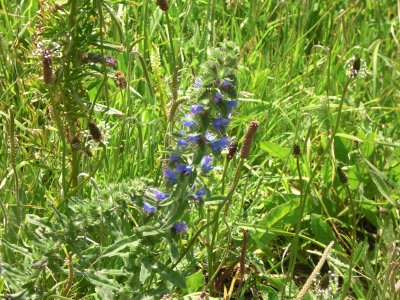
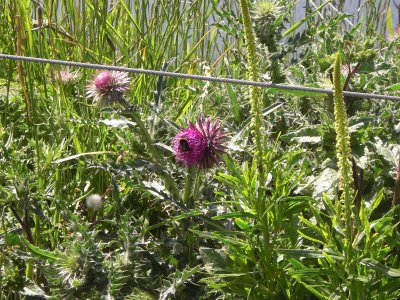 When we were there, the grassy areas between the roped-off paths were a mass of wildflowers. Big blue spikes like the one at the left were everywhere. I don't know what they were, but my guess would be something in the Acanthaceae. Around it, you can see many Plantago flower heads. Many of the plants harbored young escargots.
When we were there, the grassy areas between the roped-off paths were a mass of wildflowers. Big blue spikes like the one at the left were everywhere. I don't know what they were, but my guess would be something in the Acanthaceae. Around it, you can see many Plantago flower heads. Many of the plants harbored young escargots.
At the right, a bumblebee visits a large half-open thistle flower. To the right of the thistle are two tall, slender spikes of a pale yellowish-green flower, also very common, that I couldn't immediately identify. I wish we'd had more time (and I'd had an appropriate book with me) to study the plants, but that's not really what we were there to see.
We ran out of time, so we never got as far as Utah Beach. Getting there would have taken quite a while, because, although we could clearly see it from Pointe du Hoc, it was separated from us by a broad estuary that we would have had to drive around. We had hoped to get as far as Sainte Mère Église at some point in the trip, to see the highly recommended Airborne museum, but that would have been even farther.
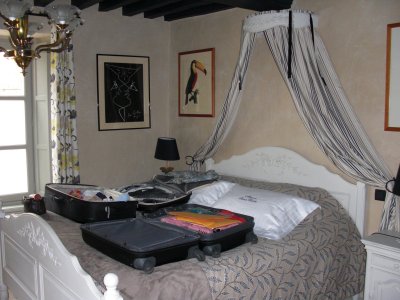
 In Bayeux, which is only about 15 minutes from the coast, after the usual three loops through the the downtown tangle of one-way (and closed-for-construction) streets, we located our B&B, the Manoir Sainte Victoire, which was wonderful! At the left is a view of part of our spacious and comfortable ground-floor room (the "Cocteau").
In Bayeux, which is only about 15 minutes from the coast, after the usual three loops through the the downtown tangle of one-way (and closed-for-construction) streets, we located our B&B, the Manoir Sainte Victoire, which was wonderful! At the left is a view of part of our spacious and comfortable ground-floor room (the "Cocteau").
At the right is the view from our window, over the garden wall and adjacent buildings, to the two towers of the cathedral. Besides an armoir, table and two chairs, and chest of drawers, the room boasted a stainless-steel kitchenette with two burners, oven, microwave, half-height fridge, and sink and a bathroom with a magnificent shower head, a foot across, supplemented by a hand-held sprayer.
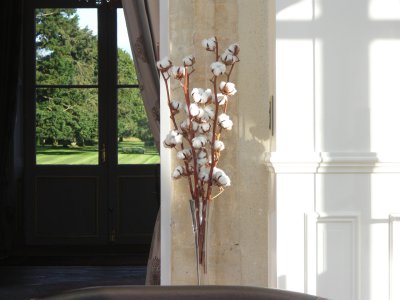
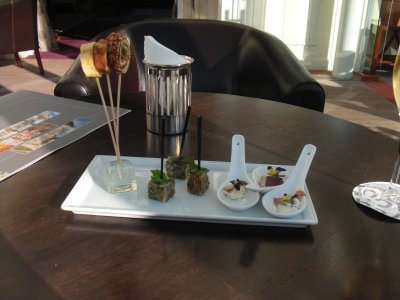 Dinner that night was at Château de Sully, between Bayeux and the coast, several miles away. Recent experience led us to allow plenty of time, so we got there so early that we took a scenic drive around the countryside before returning and presenting ourselves at the door. As you can see in this photo of an ornamental vase of cotton (one of several), the sun was out. They initially seated us in the glass-enclosed winter garden to study the menus, but it proved so much like sitting under a focused magnifying that we quickly chose to move to the cooler dining room.
Dinner that night was at Château de Sully, between Bayeux and the coast, several miles away. Recent experience led us to allow plenty of time, so we got there so early that we took a scenic drive around the countryside before returning and presenting ourselves at the door. As you can see in this photo of an ornamental vase of cotton (one of several), the sun was out. They initially seated us in the glass-enclosed winter garden to study the menus, but it proved so much like sitting under a focused magnifying that we quickly chose to move to the cooler dining room.
With the champagne, we were served this initial amuse-bouche of rolled salmon-and-crepe lollipops, little cubes of andouille (I think), and tasty bites of some sort of mousse with bacon and pansies on top.

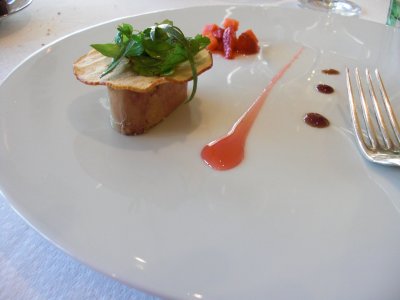 During our perusal of the menu, we were brought a short, fat, warm baguette of house-made pain à l'ancien, sliced into convenient chunks, and once we had ordered, the main amusse-bouche came—cold leek soup sprinkled with onion blossoms.
During our perusal of the menu, we were brought a short, fat, warm baguette of house-made pain à l'ancien, sliced into convenient chunks, and once we had ordered, the main amusse-bouche came—cold leek soup sprinkled with onion blossoms.
First course: Foie gras poached in "Pommeau" (a liqueur made from the pulp left after cider is pressed), with apple-strawberry compote. The disk on top of the foie gras is a crisp, dried, cross section of a whole apple.
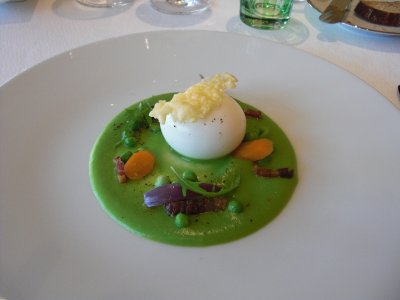
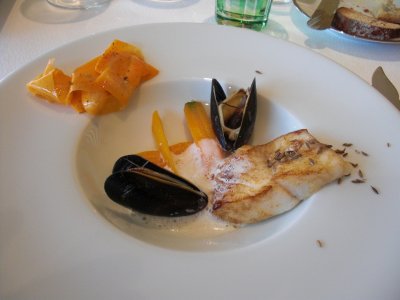 Second course: An organic egg, soft boiled, on a bed of pea purée with peas, carrots and lardons of Bayeaux pork, garnished with one strip of red onion and, on top of the egg, a Parmesan crisp.
Second course: An organic egg, soft boiled, on a bed of pea purée with peas, carrots and lardons of Bayeaux pork, garnished with one strip of red onion and, on top of the egg, a Parmesan crisp.
Third couse: A slice of turbot, sautéed in salted butter and garnished with carrots, mussels, and an emulsion of cumin. The orange ribbons on the edge of the plate are additional carrot, marinated in something delicious, and the scattered seeds are toasted cumin, which went amazingly well with the fish, which was superb. On outstanding dish.

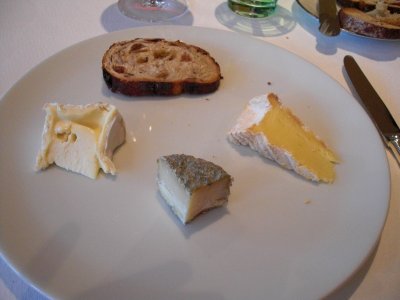 Fourth course: Roasted pigeon with potatoes, turnips, and new onions and a sauce thickened with the liver and preserved lemon.
Fourth course: Roasted pigeon with potatoes, turnips, and new onions and a sauce thickened with the liver and preserved lemon.
Cheese: My plate shown. I chose a nameless, dry, ashed chevre (bottom), pavé d'Auge (right), and Crêmeux de Mont St. Michel, which I had never had before and was excellent. CJ had the same Crêmeux de Mont St. Michel, pavé d'Isigny, and Livarot. David had Gruyère de something (Cargouge?), Neuchatel, and a fresh chevre. All were served with special flax-seed-and-raisin bread. (I was a little surprised to see so many fields of flax growing in Normandy, until I remembered how popular flax seed has gotten.)

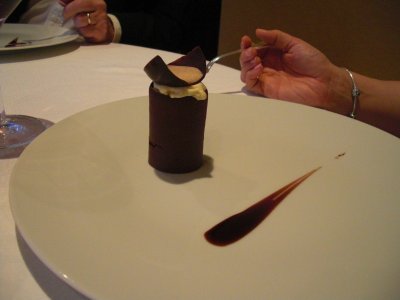 Predessert (not, our waiter assured us, one of the two official desserts that came with our meal): A panna cotta topped with a cold strawberry soup.
Predessert (not, our waiter assured us, one of the two official desserts that came with our meal): A panna cotta topped with a cold strawberry soup.
First (official) dessert: A tall cylinder of chocolate filled with, from the bottom up, a layer of "praliné" and tonka-bean ice cream, topped with a decorative chocolate sheet and more ice cream. I asked about the tonka beans and were told they were a kind of black almonds (in French, "almond" can be either the nut or anything about that shape), so CJ thought she'd better avoid them—they filled her dessert with vanilla ice cream. I've since looked them up, and tonka beans are actually beans (the seeds of Dipteryx odorata, a South American tree in the abaceae). CJ can eat beans and peas, so she ought to be able to eat tonka, but she's allergic to peanuts, which are also in that family; go figure.
Another thing that puzzled me is the "praliné." Every description, photo, and recipe for praliné I've ever found calls it almond brittle, which is usually crushed and used to flavor creams and ganaches, so commonly that the genetic term for Valentine's Day-type chocolates in France is "pralinés." In this case, though, the waiter swore to me that no nuts of any kind were involved, CJ ate it without ill effect, and I was delighted to find that it was the mysterious substance that I call sparkle-crispy. So what the heck was it? Not almond brittle, clearly, but my attempts to find any other recipe for something called praliné have been completely unsuccessful. Maybe it's just "nothing brittle"—very thin sheets of unadulterated hard caramel, crushed to a flaky powder and added to chocolate ganache.
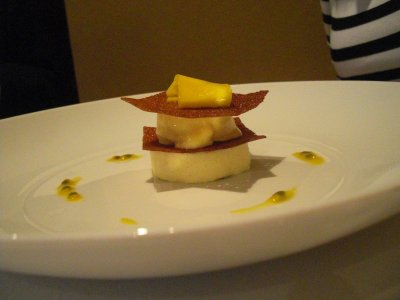
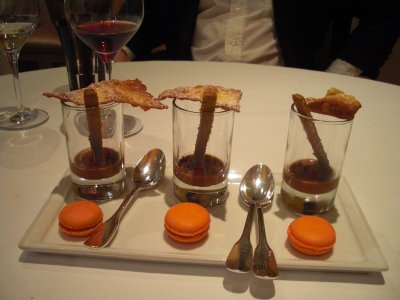 Second dessert: A "millefeuille" of passion fruit—passionfruit mousse, passionfruit sorbet, and thin ribbons of passion-fruit-marinated fresh mango, separted by crispy cookies.
Second dessert: A "millefeuille" of passion fruit—passionfruit mousse, passionfruit sorbet, and thin ribbons of passion-fruit-marinated fresh mango, separted by crispy cookies.
Mignardises: Tiny glasses of chocolate with pastry straws and chips for dipping. Apricot macaroons.
This meal is our unanimous choice for best service of the trip. The food was great, but the waitstaff made the whole experience immeasurably better. We'd go back there anytime.
previous entry
List of Entries
next entry
 The Hôtel Astrid has no breakfast room. You therefore specify the night before what time you want your breakfast and what hot drink you want with it, and they bring it to your room on a tray. Our room was quite large and included a table and four chairs, so CJ just joined us at breakfast time. Here's her tray, with a croissant, bread, butter, jam, OJ, plain yogurt, and coffee. Ours was the same but with two of everything and with hot chocolate (because they didn't have decaf).
The Hôtel Astrid has no breakfast room. You therefore specify the night before what time you want your breakfast and what hot drink you want with it, and they bring it to your room on a tray. Our room was quite large and included a table and four chairs, so CJ just joined us at breakfast time. Here's her tray, with a croissant, bread, butter, jam, OJ, plain yogurt, and coffee. Ours was the same but with two of everything and with hot chocolate (because they didn't have decaf).
 Behind the semicircular monument is this long, semicircular wall (at the left, about 1/4 of it visible in the photo) on which are engraved the thousands of names of those with no known graves. In front of it is this vista down the center axis toward the little chapel. Remember that the chapel marks only the half-way point—as many graves continue on beyond it.
Behind the semicircular monument is this long, semicircular wall (at the left, about 1/4 of it visible in the photo) on which are engraved the thousands of names of those with no known graves. In front of it is this vista down the center axis toward the little chapel. Remember that the chapel marks only the half-way point—as many graves continue on beyond it.
 On the left is a closer view of the beautiful water lilies blooming in the reflecting pool.
On the left is a closer view of the beautiful water lilies blooming in the reflecting pool.
 These two quotations were engraved on walls of the museum. The French one reads "We do not forget, we will never forget, the debt of infinite gratitude that we have incurred toward those who gave their all for our liberation" (René Coty, a former president of France). The English one says, "If ever proof were needed that we fought for a cause and not for conquest, it would be found in these cemeteries. Here was our only conquest. All we asked . . . was enough soil in which to bury our gallant dead" (General Mark W. Clark, Chairman, American Battle Monuments Commission, 1969–1984).
These two quotations were engraved on walls of the museum. The French one reads "We do not forget, we will never forget, the debt of infinite gratitude that we have incurred toward those who gave their all for our liberation" (René Coty, a former president of France). The English one says, "If ever proof were needed that we fought for a cause and not for conquest, it would be found in these cemeteries. Here was our only conquest. All we asked . . . was enough soil in which to bury our gallant dead" (General Mark W. Clark, Chairman, American Battle Monuments Commission, 1969–1984).

 Here's my cold, cooked "tourteaux" crab (Cancer pagurus), before and after I dealt with it. The kitchen had lifted the carapace and removed the gills and cartilaginous stomach sac before setting it back in place, but it was otherwise intact. I was brought a serious shell cracker (visible behind the glass dish of mayo) and one of those skinny little two-tined seafood forks with which to tackle it.
Here's my cold, cooked "tourteaux" crab (Cancer pagurus), before and after I dealt with it. The kitchen had lifted the carapace and removed the gills and cartilaginous stomach sac before setting it back in place, but it was otherwise intact. I was brought a serious shell cracker (visible behind the glass dish of mayo) and one of those skinny little two-tined seafood forks with which to tackle it.
 Our next stop was la Pointe du Hoc, a high, prominent point of land that commanded a vast swath of the sea between Omaha and Utah beaches and, once heavily fortified by the Gemans, could shell both landing areas. We had been able to see it, marked by the distinctive freestanding rocky point, all the way from Gold Beach, a good 30 km away.
Our next stop was la Pointe du Hoc, a high, prominent point of land that commanded a vast swath of the sea between Omaha and Utah beaches and, once heavily fortified by the Gemans, could shell both landing areas. We had been able to see it, marked by the distinctive freestanding rocky point, all the way from Gold Beach, a good 30 km away. 
 The fortifications were certainly impressive—a whole warren of concrete bunkers, blockhouses, and tunnels built into the point and the land beyind it. Some were quite intact, like the subterranean section at the left. You could walk around and explore many of them and peer down airshafts into others. The whole area was deeply pocked with shell holes.
The fortifications were certainly impressive—a whole warren of concrete bunkers, blockhouses, and tunnels built into the point and the land beyind it. Some were quite intact, like the subterranean section at the left. You could walk around and explore many of them and peer down airshafts into others. The whole area was deeply pocked with shell holes.
 When we were there, the grassy areas between the roped-off paths were a mass of wildflowers. Big blue spikes like the one at the left were everywhere. I don't know what they were, but my guess would be something in the Acanthaceae. Around it, you can see many Plantago flower heads. Many of the plants harbored young escargots.
When we were there, the grassy areas between the roped-off paths were a mass of wildflowers. Big blue spikes like the one at the left were everywhere. I don't know what they were, but my guess would be something in the Acanthaceae. Around it, you can see many Plantago flower heads. Many of the plants harbored young escargots.
 In Bayeux, which is only about 15 minutes from the coast, after the usual three loops through the the downtown tangle of one-way (and closed-for-construction) streets, we located our B&B, the Manoir Sainte Victoire, which was wonderful! At the left is a view of part of our spacious and comfortable ground-floor room (the "Cocteau").
In Bayeux, which is only about 15 minutes from the coast, after the usual three loops through the the downtown tangle of one-way (and closed-for-construction) streets, we located our B&B, the Manoir Sainte Victoire, which was wonderful! At the left is a view of part of our spacious and comfortable ground-floor room (the "Cocteau"). 
 Dinner that night was at Château de Sully, between Bayeux and the coast, several miles away. Recent experience led us to allow plenty of time, so we got there so early that we took a scenic drive around the countryside before returning and presenting ourselves at the door. As you can see in this photo of an ornamental vase of cotton (one of several), the sun was out. They initially seated us in the glass-enclosed winter garden to study the menus, but it proved so much like sitting under a focused magnifying that we quickly chose to move to the cooler dining room.
Dinner that night was at Château de Sully, between Bayeux and the coast, several miles away. Recent experience led us to allow plenty of time, so we got there so early that we took a scenic drive around the countryside before returning and presenting ourselves at the door. As you can see in this photo of an ornamental vase of cotton (one of several), the sun was out. They initially seated us in the glass-enclosed winter garden to study the menus, but it proved so much like sitting under a focused magnifying that we quickly chose to move to the cooler dining room.
 During our perusal of the menu, we were brought a short, fat, warm baguette of house-made pain à l'ancien, sliced into convenient chunks, and once we had ordered, the main amusse-bouche came—cold leek soup sprinkled with onion blossoms.
During our perusal of the menu, we were brought a short, fat, warm baguette of house-made pain à l'ancien, sliced into convenient chunks, and once we had ordered, the main amusse-bouche came—cold leek soup sprinkled with onion blossoms.
 Second course: An organic egg, soft boiled, on a bed of pea purée with peas, carrots and lardons of Bayeaux pork, garnished with one strip of red onion and, on top of the egg, a Parmesan crisp.
Second course: An organic egg, soft boiled, on a bed of pea purée with peas, carrots and lardons of Bayeaux pork, garnished with one strip of red onion and, on top of the egg, a Parmesan crisp.
 Fourth course: Roasted pigeon with potatoes, turnips, and new onions and a sauce thickened with the liver and preserved lemon.
Fourth course: Roasted pigeon with potatoes, turnips, and new onions and a sauce thickened with the liver and preserved lemon.
 Predessert (not, our waiter assured us, one of the two official desserts that came with our meal): A panna cotta topped with a cold strawberry soup.
Predessert (not, our waiter assured us, one of the two official desserts that came with our meal): A panna cotta topped with a cold strawberry soup.
 Second dessert: A "millefeuille" of passion fruit—passionfruit mousse, passionfruit sorbet, and thin ribbons of passion-fruit-marinated fresh mango, separted by crispy cookies.
Second dessert: A "millefeuille" of passion fruit—passionfruit mousse, passionfruit sorbet, and thin ribbons of passion-fruit-marinated fresh mango, separted by crispy cookies.